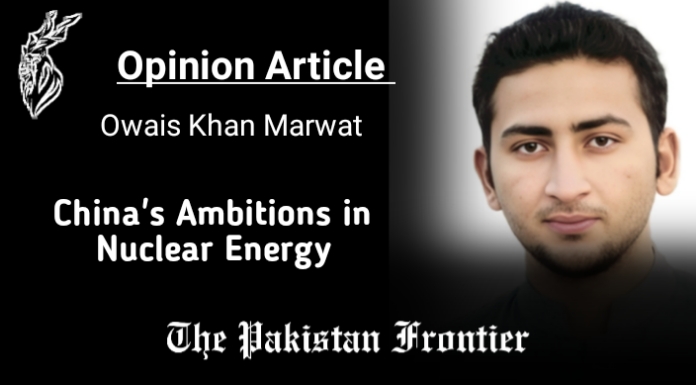BERLIN — China’s intentions to make nuclear power a significant part of its energy future will likely sit well with organizers of the upcoming COP-28 climate summit, who feel that atomic energy is necessary to help wean the globe off fossil fuels.
China, the world’s largest carbon emitter, is moving forward with ambitious plans for new nuclear development even though high-profile incidents at Three Mile Island, Chornobyl, and Fukushima have damaged the image of nuclear power in much of the globe.
A September article in the state-run news outlet Xinhua stated Beijing had approved at least 21 new power units since 2021, with a projected approval rate of six to eight new nuclear units per year.
According to the report, the nation, which already produces more electricity from nuclear sources than any other nation save the United States, wants to use atomic energy to provide 10% of its electricity demands by 2035 and 18% by 2060.Sultan Al Jaber, the president of the United Nations Climate Change Conference (COP 28), which begins on November 30 in Dubai, is likely to approve of that endeavor. Jaber called nuclear power a “strong bridge” in the energy transition and stated as much to Agence France-Presse earlier this year.
But if China is to achieve its objective, there are still many challenges to overcome and a long way to go. Nuclear energy presently ranks last among other renewable energy sources, such as thermal, hydro, wind, and solar, and only makes up 2.2% of the nation’s installed electricity-producing capacity.
According to Philip Andrews-Speed, senior research fellow at the Oxford Institute of Energy Studies, safety concerns following Japan’s catastrophic Fukushima accident in 2011 have impeded the growth of China’s nuclear energy.
Following the Fukushima accident, [China] halted building any new nuclear power stations. “They upheld the policy that prohibits constructing any inland nuclear power facilities,” Andrews-Speed told VOA during a video conference.
Because they require a lot of fresh water to run, the plants that will be constructed are anticipated to be scattered around the coast. Discharging highly radioactive effluent into adjacent water bodies is also thought to be less dangerous.
The nuclear expert continued, “Because of their complicated nature and safety considerations, nuclear plants take longer to build and put into operation than other clean energy plants like solar and wind plants.” There is presently a labor shortage in this industry in China.
There are now over 55 nuclear power stations in operation in China and about 20 more in construction. Bing Lam Luk, chairperson of the Hong Kong Nuclear Society and manager of the City University of Hong Kong’s laboratory, believes reaching 10% of the energy mix might be challenging by 2035.”
Building a single plant typically takes ten years or longer, so achieving 10% may be challenging unless authorities expedite the approval process for new facilities. Another problem is that it’s getting harder and harder to locate a new location for it along the coast,”Luk stated over the phone.
Even though China has never experienced a catastrophic nuclear catastrophe, some localities oppose the presence of a plant close by. Luk noted that public outcry forced the cancellation of a 2013 plan to construct a nuclear fuel center in Guangdong. He stated that to alter such a view, more public education will be required.
Meanwhile, Luk noted that the advent of fourth-generation and small modular reactors,which make large-scale accidents “almost unthinkable,” is making people less concerned about safety. He said China could alter its policies and construct more nuclear power plantsinland.According to Luk, smaller modular reactors are more accessible to transport and install than their larger counterparts and are also more energy-efficient. According to him,Tsinghua University in Beijing is currently testing fourth-generation technology that uses helium instead of water coolant since it is more heat resistant and lowers the chance of anexplosion.Though hailed as the nuclear energy of the future, these reactors can produce more radioactive waste than traditional ones, according to a Stanford and the University of British Columbia study.China, the United States, France, Japan, South Korea, and Britain have a long history of exchanging technical information, which will likely help China construct fourth-generationreactors.
For example, China and France began working together a few decades ago. China constructed its first two nuclear power reactors in the mid-1980s, close to Hong Kong,using foreign technology under the management of Electricite de France, a state-owned energy company.
Following this, China launched several cooperative ventures. In April this year, the two nations released a joint declaration on “expanding pragmatic cooperation in the sphere of civilian nuclear energy.” They committed to working together to reprocess nuclear waste.
According to Andrews-Speed, France is ahead of China in reprocessing spent fuel. Thus,the two can collaborate on this. With plans to open in 2035, France is constructing a facility 500 meters below the surface to dispose of radioactive waste. China will start building a garbage site in at least the 2040s.
Another obstacle may come from geopolitical tensions between the West and China.Amidst deteriorating U.K.-China relations, Britain eliminated a Chinese business from its Sizewell nuclear project last year.
After decades of collaboration, the U.S. recently tightened restrictions on its nuclear trade with China, citing “national security interests” and “common defense.” However, China has been selling nuclear technology to other nations, including Pakistan.
When questioned about nuclear energy’s place at this year’s COP-28, Luk stated that it will probably continue to be a significant topic of debate for energy transition.”Nuclear energy will probably continue to increase steadily because energy storage is still a problem for renewable energy sources,” he stated.
The author is a Research Professional at the Institute of Strategic Studies Islamabad (ISSI) and an Author at Stratheia-Margalla Policy Digest. He graduated with a BS in International Relations from the University of Peshawar. He can be reached at [email protected]*
